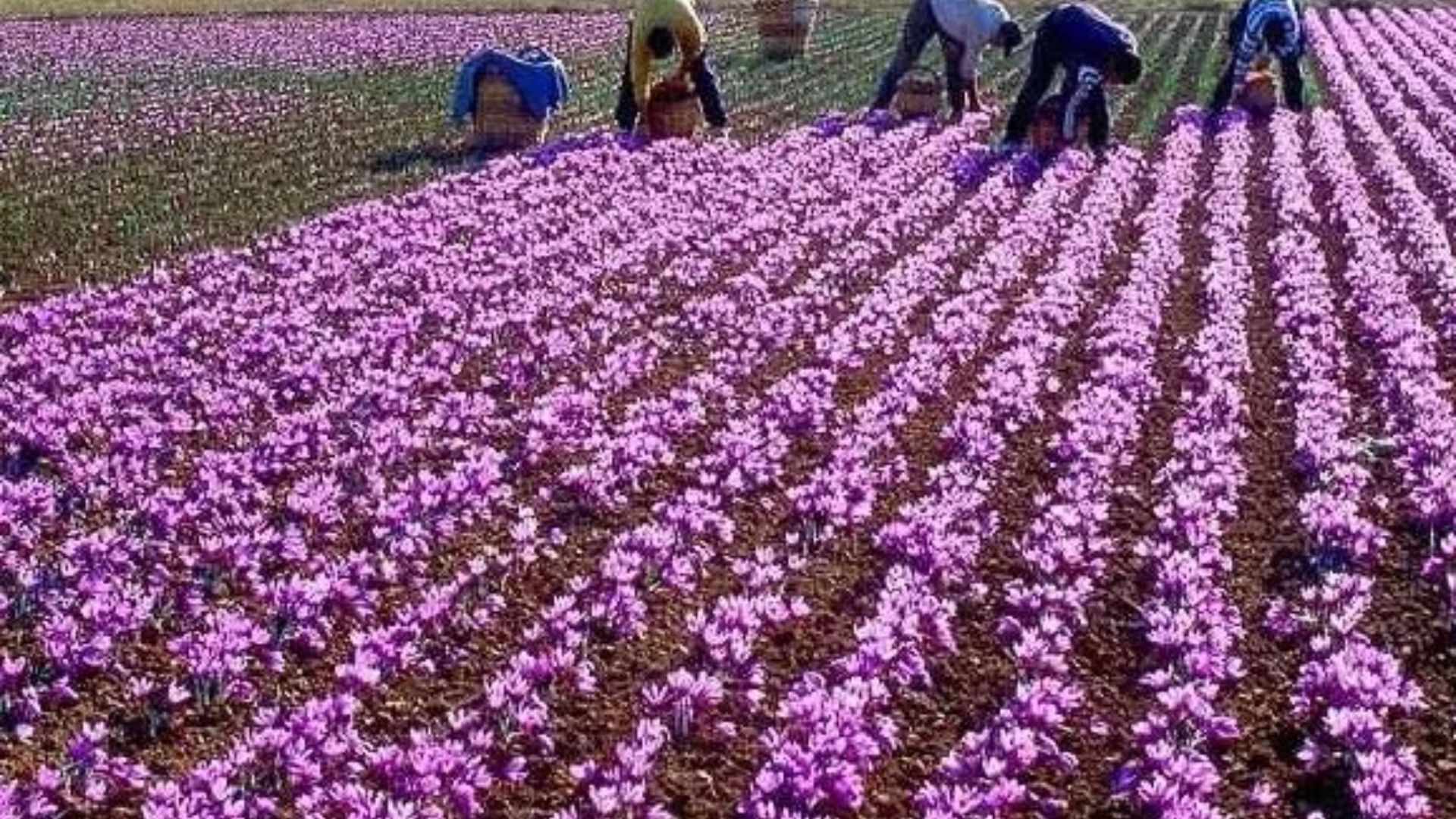
Early Times Report
SRINAGAR, Sept 21: In Kashmir Valley, saffron has long been more than just a crop; it is a symbol of heritage and a vital source of income for local farmers. But its farming is grappling with significant sustainability and livelihood issues, highlighting the urgent need for suitable technologies to combat global warming. As global temperatures rise, the very foundations of this traditional cultivation industry are under siege. Erratic weather patterns, unseasonable warmth, and diminishing snowfall have disrupted the delicate balance required for saffron cultivation.
Farmers who have invested their lives in this aromatic harvest are now facing uncertainty and declining yields, jeopardizing their livelihoods and the cultural legacy of saffron production.
Saffron production, which once reached nearly 17 tons annually, has now stabilized at around 15 tons.
However, the technology and research being done by the Advanced Research Centre for Saffron and Seed Spices in the Pampore district of Jammu and Kashmir– the only Saffron research centre in India– is continuously engaged in increasing the production of the crop.
“Due to changing weather patterns, the research centre has developed an irrigation schedule for saffron farmers. This schedule, detailing when and how much irrigation the crop requires, has been shared with the Department of Agriculture. The research centre has provided comprehensive guidance covering all aspects of saffron cultivation, from land preparation and seed sowing to intercultural operations, harvesting, and post-harvest management, which is now accessible to our farmers,” Bashir Ahmad Ilahi, Professor in Head Saffron Research Station, Pampore, said.
He said that saffron seeds are ideally sown in late July, with the crucial condition that the soil remains moist but not waterlogged.
“The flowers typically begin to bloom between October 10 and 15, and harvesting occurs regularly by November 15. Once sown, the saffron crop can yield new produce for the next 4 to 5 years,” Ilahi said.
This delicate spice, revered for its rich flavour and vibrant colour, flourishes in the unique climate of the region, cultivated across 3,500 hectares by generations of dedicated growers.
AB Wani, a Saffron grower, said that his family has been engaged in saffron farming for decades, particularly in the Pampore area of Kashmir.
“Unfortunately, saffron production has declined in recent years. While India’s demand for saffron reaches nearly 50 tons, we only produce about 10 to 12 tons. To support saffron farmers, the Indian government established a Saffron Park in Pampore in 2014, which became operational in 2020. Over 500 farmers bring their harvests here for testing, drying, and marketing. The facility also provides a Geographical Indication (GI) tag, which helps prevent adulteration and ensures the quality of our saffron,” Wani said.
He said that Prime Minister Narendra Modi personally promoted GI-tagged saffron, ensuring customers receive authentic saffron t As global temperatures rise, the very foundations of this traditional cultivation industry are under siege.
Erratic weather patterns, unseasonable warmth, and diminishing snowfall have disrupted the delicate balance required for saffron cultivation.
Farmers who have invested their lives in this aromatic harvest are now facing uncertainty and declining yields, jeopardizing their livelihoods.
Saffron production, which once reached nearly 17 tons annually, has now stabilized at around 15 tons.
“All saffron farmers sell their products at the Saffron Park within two months. This facility houses the only authenticated saffron laboratory in Asia, specifically designed to meet the demands of Kashmiri saffron. While saffron is also produced in Iran and Afghanistan, Kashmiri saffron is classified as Grade 1, renowned for its superior quality,” he said.
Wani said that the world’s best saffron is produced in Pampore, where prices range from 1.10 lakh to 1.25 lakh per kilogram.
“Since the establishment of the Saffron Park, we have been able to sell saffron for as much as 2.50 lakh per kilogram. Pampore stands as the major hub for saffron farming in the region.
“Global warming has contributed to a decline in saffron crops, with untimely rainfall adversely affecting production. Previously, annual yields ranged from 15 to 17 tons, but this has decreased in recent years. Fortunately, last year saw timely rainfall, allowing the crop to recover to previous levels. This year, the rain has arrived on time once again, and we remain hopeful that the crop will be plentiful,” he added.
Vaibhav Sharma, a customer from Dwarka in Delhi, said that he is in Pampore to purchase saffron and Kashmir’s renowned honey.
“The shopkeeper showcased a classification of saffron and demonstrated Kashmiri Saffron’s excellent quality,” he said.
Ashraf Gull, Saffron grower and trader from Pampore, said that he is both a saffron farmer and trader, specializing in organic saffron.
“Our production ranges from 10 to 15 tons, but it is declining due to climate change. Here, saffron is priced at around Rs 300 per gram, while it can sell for Rs 700 per gram outside Kashmir. Saffron is well-known for its medicinal properties, particularly its benefits for treating coughs and promoting overall health,” Gull said.
Saffron is mentioned in the 5th century B.C. in Kashmiri records and is still part of the agricultural economy. Integrated in annual crop system, Saffron is also a cash crop. With respect to occupation, only one per cent of saffron growers are dependent on any other agriculture.
Saffron is part of the cultural heritage of the region, associated with the famous Kashmiri cuisine, its medicinal values and the rich cultural heritage of Kashmir.
With each passing season, the once-reliable rhythms of nature become increasingly unpredictable, casting a shadow over the vibrant fields that have thrived for centuries. The implications extend beyond agriculture; they touch the heart of the community, threatening not only economic stability but also the deep-rooted traditions that bind the farmers to their land.
As the crisis unfolds, the farmers of Kashmir stand at a crossroads, seeking solutions to adapt and survive in a warming world while holding onto their cherished saffron heritage.
The fight to preserve this precious crop symbolizes a broader struggle against climate change, urging collective action to safeguard not just their livelihood, but the very essence of their culture. |
